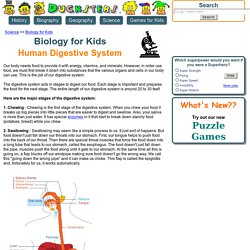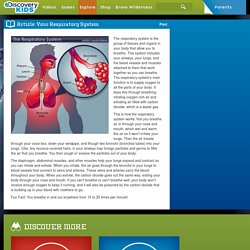

Muscles (Science Trek: Idaho Public Television) StudyJams. Muscle Facts for Kids. If bones give your body support, muscles give it power.

You have over 600 muscles in your body. Some of these muscles control big movements, like the muscles in your arms and legs. Other muscles control very tiny movements, like blinking. Most of your muscles are attached to bones with tendons. Tendons are like strong rubber bands or ropes. Voluntary muscles are those that you choose to move. Voluntary muscles are those that you choose to move. All About Human Body Muscles: Working your muscles makes them stronger. Human Body Muscle Vocabulary Power: strength, energyControl: drive or manageTendon: rope-like material that attaches muscle to boneCramp: involuntary muscle squeezing. Biology for Kids: Muscles in the Human Body. Skeletal Muscle Definition. Human Skeleton for Kids. Bone and Skeleton Fun Facts for Kids.
Sure, a skeleton looks sort of creepy, but without it, you’d be little more than a pile of jelly.

StudyJams. Skeletal System for Kids - Science Games and Videos. Skeletal System for Kids The human skeletal system provides the shape and form for our bodies.

It protects our internal organs and allows bodily movement. The skeletal system consists of the body's bones, cartilage, joints, ligaments, tendons and other connective tissues. It also serves as a repository for various minerals such as calcium and phosphorus. Our skeletal system along with the attached muscles allows us to walk, run, hold something, write, move our head and perform all other body movements. Play Quiz Games : NeoK12 is iPad & Android tablet ready. Science Games, Diagrams & Activities : Pictures & School Presentations : Science Videos & Lessons:(Reviewed by K-12 teachers) Search Videos. Dry bones. How Does the Digestive System Work for Kids. Mouth Mouth Digestion begins in the mouth, where teeth cut and crush food into small pieces.

In the mouth › Also called the gullet, this muscular tube transports food from the throat to the stomach. The liver is a large organ, which processes nutrients and produces bile, a green liquid that helps break down fat. Science for Kids: The Digestive System. Our body needs food to provide it with energy, vitamins, and minerals.

However, in order use food, we must first break it down into substances that the various organs and cells in our body can use. The Human Digestive System. Your Digestive System. The story we’re about to tell is of stormy seas, acid rains, and dry, desert-like conditions.

It’s an arduous journey that traverses long distances and can take several days. It’s one in which nothing comes through unchanged. It’s the story of your digestive system whose purpose is turn the food you eat into something useful — for your body! Down the Hatch It all starts with that first bite of pizza. Your teeth tear off that big piece of crust. Next, your muscles squeeze the wet mass of food down, down, down a tube, or esophagus, the way you would squeeze a tube of toothpaste. Inside your stomach Imagine being inside a big pink muscular bag — sloshing back and forth in a sea of half-digested mush and being mixed with digestive chemicals. Sound a little like an amusement ride gone crazy? StudyJams. Facts About The Lungs. Your lungs and the airways that carry air in and out of your body are located in your head and chest.

The airways include the nasal cavity, the throat, the voice box (larynx), and the branching passages inside your lungs. Nose Nose Your nose warms and cleans air as it passes through the nasal cavity. To keep your airways clear, air is sometimes blasted out of your nose with a sneeze. Coughs and sneezes › Mouth Mouth. Science for Kids: Breathing and the Respiratory System. Humans breathe through something called the respiratory system.

This system is made up primarily of our lungs and windpipe. Why do we have to breathe? Our body is a very complex system. One of the main things it needs is energy. When we eat our body digests the food to get complex molecules like glucose, which it can use for energy. Breathing In We breathe in using a muscle called the diaphragm. Breathing System Facts for Kids. From the moment you are born, you breathe – in and out – all day and all night long.

When you inhale, your lungs draw in oxygen, a gas in the air that we need to live. The oxygen is then sent through the blood to all parts of your body, where it gives energy to your cells. As the cells use oxygen, they make carbon dioxide, a waste gas. You breathe this gas out when you exhale. All About Human Breathing System: Main Parts of your Respiratory System Your lungs breathe in about 2,000 gallons of air every day – enough for the 2,400 gallons of blood that go through your heart every day.
StudyJams. Your Respiratory System. The respiratory system is the group of tissues and organs in your body that allow you to breathe.

This system includes your airways, your lungs, and the blood vessels and muscles attached to them that work together so you can breathe. The respiratory system’s main function is to supply oxygen to all the parts of your body. It does this through breathing: inhaling oxygen-rich air and exhaling air filled with carbon dioxide, which is a waste gas. Heart Facts For Kids. There are three main types of vessels in your circulatory system. Arteries (red) take blood away from the heart, veins (blue) carry it back to the heart, and tiny capillaries (too small to be seen here) link the arteries and veins. Each artery has a name, which changes when it branches into smaller arteries. Similarly, the names of small veins change when they join wider main veins. Digestive System Facts for Kids. What happens when you eat your favorite food? Maybe it’s a slice of pizza or chicken nuggets. You know it tastes yummy, but what happens next? When your stomach is empty, you feel hungry.
If you smell good food, your brain reminds you that you’re hungry. StudyJams. CIRCULATORY SYSTEM. The circulatory system is centred on the HEART, a muscular organ that rhythmically pumps BLOOD around a complex network of BLOOD VESSELS extending to every part of the body. Blood carries the oxygen and nutrients needed to fuel the activities of the body’s tissues and organs, and it plays a vital role in removing the body’s waste products. An average-sized adult carries about 5 litres (9 pints) of blood. All the output of blood from the left side of the heart goes into the aorta, the body’s largest artery. Other arteries branch from the aorta to supply blood to the head, limbs, and internal organs. Circulatory System. Human Nervous System. Biology for Kids: Nervous System in the Human Body. Nervous Systems Facts for Kids. Let’s say a bee lands on your hand. A message from the nerves in your hand races to your brain –“There’s a bee on my hand.”
The nervous system. Element; neuron; brain; spinal; cord; nerve; cell; nerves; myelin; neurotransmitters; cranial; impulses; Contents The nervous system is the highway along which your brain sends and receives information about what is happening in the body and around it. This highway is made up of billions of nerve cells, or neurons (say new-rons) which join together to make nerves. A nerve is a fibre that sends impulses through the body. These fibres are covered by fatty substance called myelin (say my-e-lin). StudyJams. Health & The Human Body. The human body is an amazing thing, and to keep it healthy, it can help to understand how the body’s systems all work together.